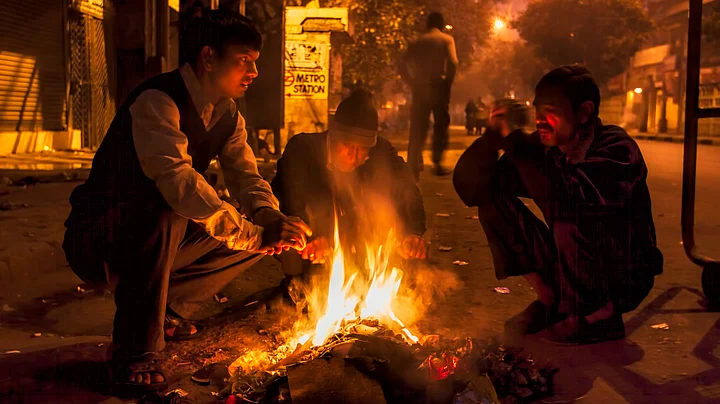Record-breaking and nail-biting winters call for an imperative and inclusive act on climate change. North Indian states like Delhi, Punjab, Rajasthan, and Himachal Pradesh are breaching all the mercury dip thresholds as the lethal cold wave of 2022 continues.
An analysis by the researchers from IPE-Global using Indian Meteorological Department’s baseline data points suggests that there has been a 1.6-fold increase in cold wave days in India in the last decade, although the long-term average is contrasting.
Three Out of Ten Indians Are Vulnerable to Cold Wave
The winters of 2023 are set to break all records, with Delhi, Punjab, recording its lowest minimum temperature. While the earth is warming, it is often asked how cold waves are whiplashing lives and livelihoods.
Naturally occurring El Nino and La Nina influence the weather patterns, and climate change is making the anomalies the new norm by altering these weather patterns.
Predictions by IMD suggest that the next two months will prevalently witness La Nina. Now, with these harsher imprecations, is India cold-wave ready?
Readiness and resilience need to go beyond normative notions and staunch implementation and integration of climate-proofing of infrastructures- it should be the inflection point.
The year-round calendar of climate extremes is already baffling lives and livelihoods. Cold waves compounded with low Air Quality Index impact public health, agricultural and human productivity much more than is reported.
Further, a young, urban-aspired India is settling around the urban hamlets- that are already grabbling with low thermal performance and basic habitation modules.
These hamlets are prone to high cold wave exposure. IMD’s vulnerability atlas suggests that 3 out of every 10 Indians have a high to very high vulnerability to cold waves. Numbers speak volumes, but actions on-ground are mild and advoc. Plotting cold-wave-ready pathway becomes a national imperative.
Making India Cold-Wave Ready
Globally, empirical evidence suggests a sharp spike in mortality due to cold waves.
As the AQI levels continue to dip across the winters, the risk is quite higher than expected. Climate change and environmental stressors make the crisis evident and signal urgent action.
These crises turn into disasters when the chronic enfeeblement of communities and state capacity becomes recurrent. How can communities and states be ready and resilient?
First, the climate risk assessments for geographies, sectors, and assets must be recurrent, scientifically validated, and hyper-local. Enacting when a climate extreme event hits are advoc and un-strategic; it cant avert the loss and damage to lives, livelihoods, and assets.
A google search is simple, quick, and takes some nano-seconds of effort to come up with a laundry list of solutions, but it ebbs in practice. Ensuring Impact- based forecasting beyond advisories can build community resilience better and quicker.
Availability and accessibility of climate information with efficient end-mile connectivity can strengthen hyper-local risk assessments.
The template of impact-based forecasting should not only de-jargonise the climate change glossary but should also make it people-centric and inform about the compound risk impacts- the one that we are currently posed with cold waves and low levels of AQI.
Cold-wave readiness will be abstained without democratising and downscaling climate informations.
Second, cold-wave readiness calls for providing affordable access to energy-efficient domestic heating appliances.
As India’s urbanization rate is fast increasing, the percentage share of urban slums is also even surging exponentially.
According to the India housing report, more than 100 million people are living in slums- which are ramshackle structures with limited power supply and basic habitation facilities, where access to energy-efficient domestic heating appliances is bobbly.
Ensuring access to efficient appliances should be cognisant of beating the cold waves without contributing to the warming planet. Therefore, the Bureau of Energy Efficiency needs to provide access to affordable, energy-efficient domestic appliances.
Promoting energy-efficient heating appliances contributes to sustainable development, generates green jobs, and ensures a better quality of life.
Third, India must climate-proof its urban habitation infrastructures to ensure climate responsiveness and cold-wave readiness. Currently, the building and standard codes do not account for climate readiness, let alone cold waves.
Aligning the housing programmes like Pradhan Mantri Awas Yojana (PMAY) and slum development schemes, and rural housing schemes with climate-responsive architecture can fetch a double dividend of building resilience and enhancing coping capacity.
Further, this should target building district-level officials; administrative capacity and an ecosystem of trained masons.
Better thermal performance habitation infrastructures are economically, environmentally, and socially sustainable.
Our collective apathy can keep the climate action wagon up and running. The time is right to align the developmental trajectories to meet the climate action trajectories, given that the adverse concerns are common and shared.
By implementing-at scale, those above-mentioned nimble people-centric interventions can make India’s lives, livelihoods, infrastructures, and economies climate-proofed and ready.
(Abinash Mohanty is the Sector Head of Climate Change and Sustainability at IPE Global. This is an opinion piece and the views expressed above are the author’s own. The Quint neither endorses nor is responsible for the same.)
